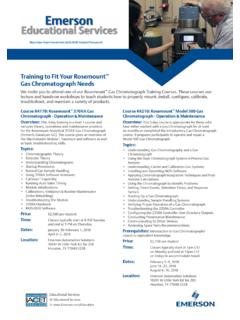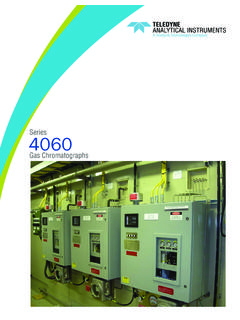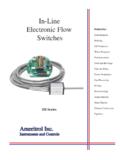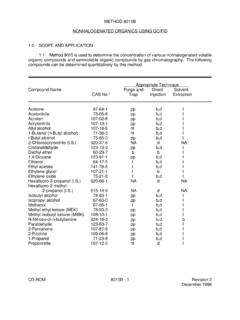Transcription of Application Note: Improving Refinery Hydrotreater …
1 Improving Refinery Hydrotreater (HDS) unit performance with process Gas ChromatographsApplication NoteRefiningFigure 1 - Flow Diagram of a Typical Hydrotreater unit in a RefineryProcess gas chromatographs have been used since the 1950s to provide real-time compositional data to process control systems. Today, there are tens of thousands of process gas chromatographs in use throughout the process industry making the gas chromatograph the analytical workhorse for on-line compositional measurements. One example of how process gas chromatographs are used for Improving process operations can be found in the hydrotreator (HDS) unit in a the processing of crude oil, it is important to chemically treat the various petroleum streams as they move from one unit to another in the Refinery .
2 Crude oil has a number of chemically unstable, unsaturated compounds that either degrade or create gum-forming compounds. There are also compounds that contain sulfur, nitrogen, dissolve metals or oxygen that must be removed for environmental reasons and to keep them from damaging catalyst used in the unit within the Refinery that performs this chemical treatment is the Hydrotreater . Within the Hydrotreater , the petroleum streams along with hydrogen pass through a catalyst-based reactor to chemically stabilize the stream. The hydrogen also reacts with the oil to produce hydrogen sulfide, ammonia and saturated hydrocarbons.
3 Finally, any metals present will adhere to the surface of the catalyst and are left behind by the petroleum stream. When the Hydrotreater is used to primarily remove sulfur, it is then called a hydro-desulfurization Hydrotreater UnitAny petroleum stream that needs treatment can become a feed stream to the Hydrotreater . The feed is mixed with a hydrogen-rich stream and is then heated by a furnace before entering the catalyst-filled exiting the reactor, the stream enters a hydrogen separator where the unreacted hydrogen, as well as other light gases, is removed from the main petroleum stream.
4 Some of this light gas stream is recycled back to the front of the unit for remixing with the fresh feed while the remainder of the light gases is sent to a sulfur removal further remove the light gases, the petroleum stream enters a stripper that sends the light gases overhead (including ammonia and sulfur compounds). This light gas stream joins the other light gases from the hydrogen separator. Exiting the bottom of the stripper is the treated petroleumstream that then heads to the appropriate unit that needs the MakeupC3H2 RecycleReactorImpurities in H2 Sour WaterDesulfurizedProductC3 & Lighterto H2 SRemovalFeed process Management Rosemount Analytical Gas chromatograph Center of Excellence10241 West Little York, Suite 200 Houston, TX 77040 USA Toll Free 866 422 3683T +1 713 396 8880 (North America)T +1 713 396 8759 (Latin America)F +1 713 466 2012 Emerson process Management.
5 All rights Emerson logo is a trademark and service mark of Emerson Electric Co. Rosemount Analytical is a mark of one of the Emerson process Management family of companies. All other marks are the property of their respective contents of this publication are presented for information purposes only, and while effort has been made to ensure their accuracy, they are not to be construed as warranties or guarantees, express or implied, regarding the products or services described herein or their use or applicability. All sales are governed by our terms and conditions, which are available on request.
6 We reserve the right to modify or improve the designs or specifications of our products at any time without #StreamComponents MeasuredMeasurement Objective1 Hydrogen recycleN2, O2, CO, CO2, C1 C3+Monitor the impurities in hydrogen2 Stripper bottomsC3 Minimize the C3 and lighter content in the finished productTable 1 - Summary of process Gas chromatograph Applications in a Typical Refinery Hydrotreater UnitThe Emerson solutionEmerson has a long history of providing process gas chromatographs to the refining industry. Emerson's process gas chromatographs have set the standard for on-line process measurement by supplying analyzers that are both robust and capable of handling the analytical Hydrotreater unit performance with process Gas ChromatographsThere are two common measurement points in a Hydrotreater unit .
7 The first gas chromatograph (AX #1 in Figure 1) monitors the impurities in the hydrogen recycle stream so that if any additional hydrogen is needed, it can be added with the hydrogen makeup second gas chromatograph (AX #2 in Figure 1) monitors the finished petroleum product stream exiting the bottom of the stripper. It is important to minimize the C3 and light compounds present so the gas chromatograph can measure the C3 in the stream. A summary of these applications can be seen in Figure 2.















